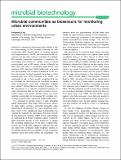| dc.contributor.author | Ling, Fangqiong | |
| dc.date.accessioned | 2018-04-05T14:05:36Z | |
| dc.date.available | 2018-04-05T14:05:36Z | |
| dc.date.issued | 2017-08 | |
| dc.identifier.issn | 1751-7915 | |
| dc.identifier.issn | 1751-7907 | |
| dc.identifier.uri | http://hdl.handle.net/1721.1/114560 | |
| dc.description.abstract | The BE microbiome is a naturally embedded biosensor in urban infrastructure that can be used to monitor environmental quality and human activity. There are many potential opportunities for leveraging BE microbial communities to guide urban design and public health policy. | en_US |
| dc.publisher | Wiley Blackwell | en_US |
| dc.relation.isversionof | http://dx.doi.org/10.1111/1751-7915.12831 | en_US |
| dc.rights | Attribution 4.0 International (CC BY 4.0) | en_US |
| dc.rights.uri | https://creativecommons.org/licenses/by/4.0/ | en_US |
| dc.source | Wiley Open Access | en_US |
| dc.title | Microbial communities as biosensors for monitoring urban environments | en_US |
| dc.type | Article | en_US |
| dc.identifier.citation | Ling, Fangqiong. “Microbial Communities as Biosensors for Monitoring Urban Environments.” Microbial Biotechnology 10, 5 (August 2017): 1149–1151 © 2017 The Author | en_US |
| dc.contributor.department | Massachusetts Institute of Technology. Department of Biological Engineering | en_US |
| dc.contributor.mitauthor | Ling, Fangqiong | |
| dc.relation.journal | Microbial Biotechnology | en_US |
| dc.eprint.version | Final published version | en_US |
| dc.type.uri | http://purl.org/eprint/type/JournalArticle | en_US |
| eprint.status | http://purl.org/eprint/status/PeerReviewed | en_US |
| dc.date.updated | 2018-02-23T19:23:11Z | |
| dspace.orderedauthors | Ling, Fangqiong | en_US |
| dspace.embargo.terms | N | en_US |
| mit.license | PUBLISHER_CC | en_US |
